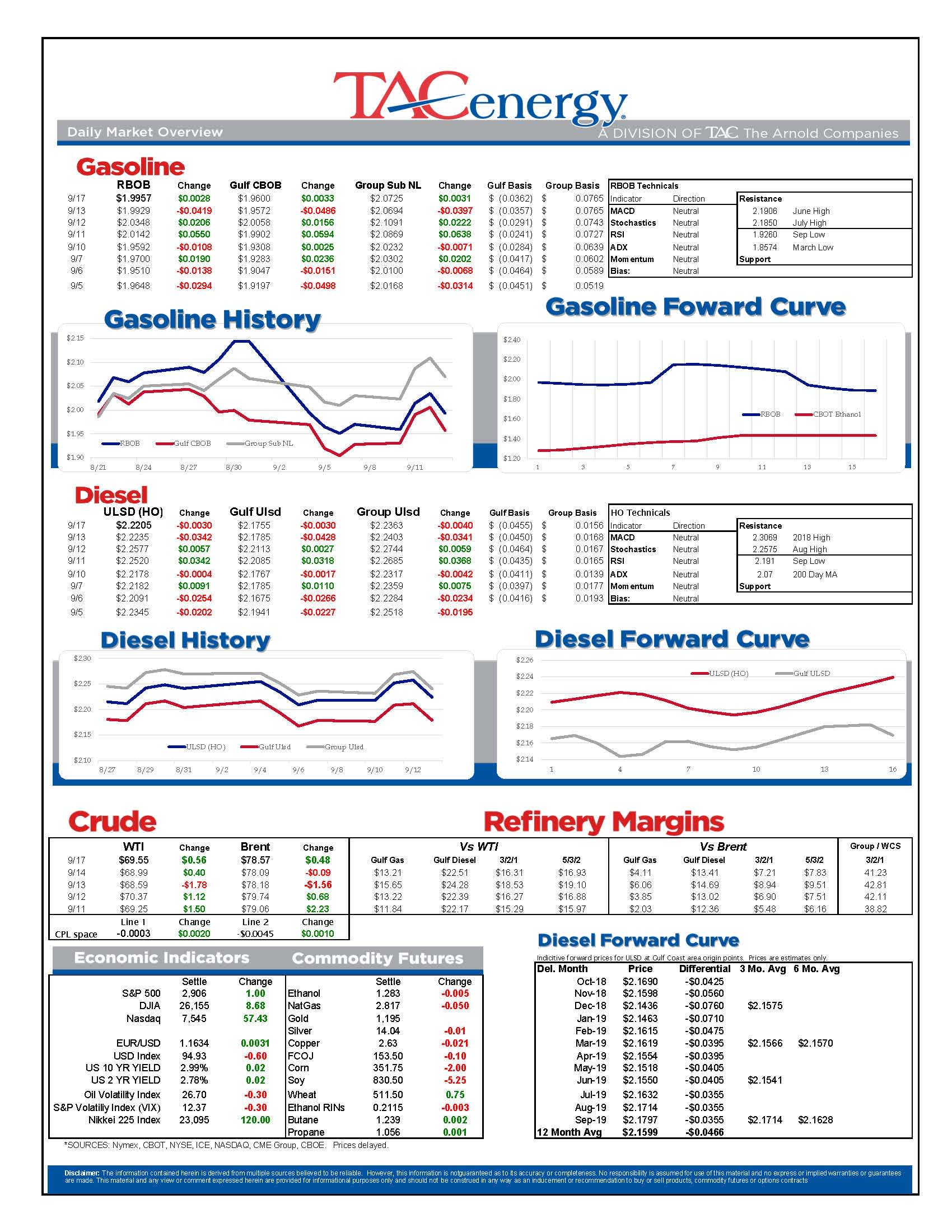Refined Product Prices Recovering Friday’s Losses

Refined product prices are recovering much of Friday’s losses so far this morning, gasoline futures are up about 2 cents to start the day, diesel futures up just half that at a penny. American crude oil contracts are extending their gains from last week as they poise to make another run at the $70 level.
Hurricane Florence came and went last week and was recently downgraded to a tropical depression early Sunday. For now it seems the largest risk to supply in the area, an outage at Colonial’s major pipeline junction in Greensboro, NC, has passed after heavy rains called for flash flood warnings that only just ended at 7:45 EDT. The depression is projected to drop 1-4 inches of rain throughout the north east region, with the heaviest rainfall focused in northern Pennsylvania, upstate New York, and Massachusetts. Aside from a single port in NC and some spot outages at retail stations near the coast, TD Florence is not expected to have any significant impact to energy infrastructure.
Invest 95L brought heavy rains and mild flooding to Houston/Galveston area but no major impacts have been reported. Fortunately, the disturbance was too close to land to develop into an organized system before making landfall Friday.
The remnants of Isaac, a tropical disturbance just to the south of Jamaica, is now the only potential storm-related threat to the US, and a distant one at that. The National Hurricane Center gives the disturbance a 10% chance to developing into a cyclone over the next 48 hours. It will continue to be monitored but potential impact remains minimal.
Baker Hughes reported an increase of 7 oil production platforms, bringing to total active rig count to a 3 ½ year high. Closures in Texas, New Mexico, and Wyoming were offset by activationss in Louisiana, Pennsylvania, and Colorado.
As expected, money managers trimmed their net long positions in WTI, RBOB, and ULSD after prices fell off the last week of August. Brent crude futures remained the lone recipient of increased bullish speculation.
Latest Posts
Week 17 - US DOE Inventory Recap
The Energy Complex Is Trading Modestly Lower So Far This Morning With WTI Crude Oil Futures Leading The Way
Energy Futures Are Drifting Quietly Higher This Morning
Refined Products Holding Close To Break Even While Oil Prices Are Losing Just Under 1%
Social Media
News & Views
View All
Week 17 - US DOE Inventory Recap

The Energy Complex Is Trading Modestly Lower So Far This Morning With WTI Crude Oil Futures Leading The Way
The energy complex is trading modestly lower so far this morning with WTI crude oil futures leading the way, exchanging hands $1.50 per barrel lower (-1.9%) than Tuesday’s settlement price. Gasoline and diesel futures are following suit, dropping .0390 and .0280 per gallon, respectively.
A surprise crude oil build (one that doesn’t include any changes to the SPR) as reported by the American Petroleum Institute late Tuesday is taking credit for the bearish trading seen this morning. The Institute estimated an increase in crude inventories of ~5 million barrels and drop in both refined product stocks of 1.5-2.2 million barrels for the week ending April 26. The Department of Energy’s official report is due out at it’s regular time (9:30 CDT) this morning.
The Senate Budget Committee is scheduled to hold a hearing at 9:00 AM EST this morning regarding a years-long probe into climate change messaging from big oil companies. Following a 3-year investigation, Senate and House Democrats released their final report yesterday alleging major oil companies have internally recognized the impacts of fossil fuels on the climate since as far back as the 1960s, while privately lobbying against climate legislation and publicly presenting a narrative that undermines a connection between the two. Whether this will have a tangible effect on policy or is just the latest announcement in an election-yeardeluge is yet to be seen.
Speaking of deluge, another drone attack was launched against Russian infrastructure earlier this morning, causing an explosion and subsequent fire at Rosneft’s Ryazan refinery. While likely a response to the five killed from Russian missile strikes in Odesa and Kharkiv, Kyiv has yet to officially claim responsibility for the attack that successfully struck state infrastructure just 130 miles from Moscow.
The crude oil bears are on a tear this past week, blowing past WTI’s 5 and 10 day moving averages on Monday and opening below it’s 50-day MA this morning. The $80 level is likely a key resistance level, below which the path is open for the American oil benchmark to drop to the $75 level in short order.
Click here to download a PDF of today's TACenergy Market Talk.

Energy Futures Are Drifting Quietly Higher This Morning
Energy futures are drifting quietly higher this morning as a new round of hostage negotiations between Israel and Hamas seem to show relative promise. It seems the market is focusing on the prospect of cooler heads prevailing, rather than the pervasive rocket/drone exchanges, the latest of which took place over Israel’s northern border.
A warmer-than-expected winter depressed diesel demand and, likewise, distillate refinery margins, which has dropped to its lowest level since the beginning of 2022. The ULSD forward curve has shifted into contango (carry) over the past month as traders seek to store their diesel inventories and hope for a pickup in demand, domestic or otherwise.
The DOE announced it had continued rebuilding it’s Strategic Petroleum Reserve this month, noting the addition of 2.3 million barrels of crude so far in April. Depending on what the private sector reported for last week, Wednesday’s DOE report may put current national crude oil inventories (include those of the SPR) above the year’s previous levels, something we haven’t seen since April of 2022, two months after Ukraine war began.
The latest in the Dangote Refinery Saga: Credit stall-out, rising oil prices, and currency exchange.
Click here to download a PDF of today's TACenergy Market Talk.